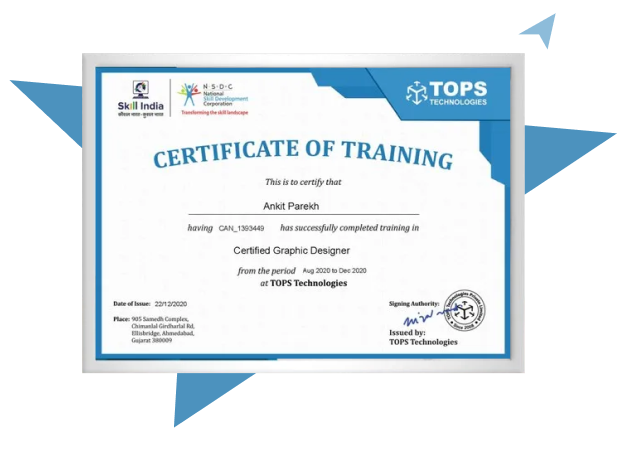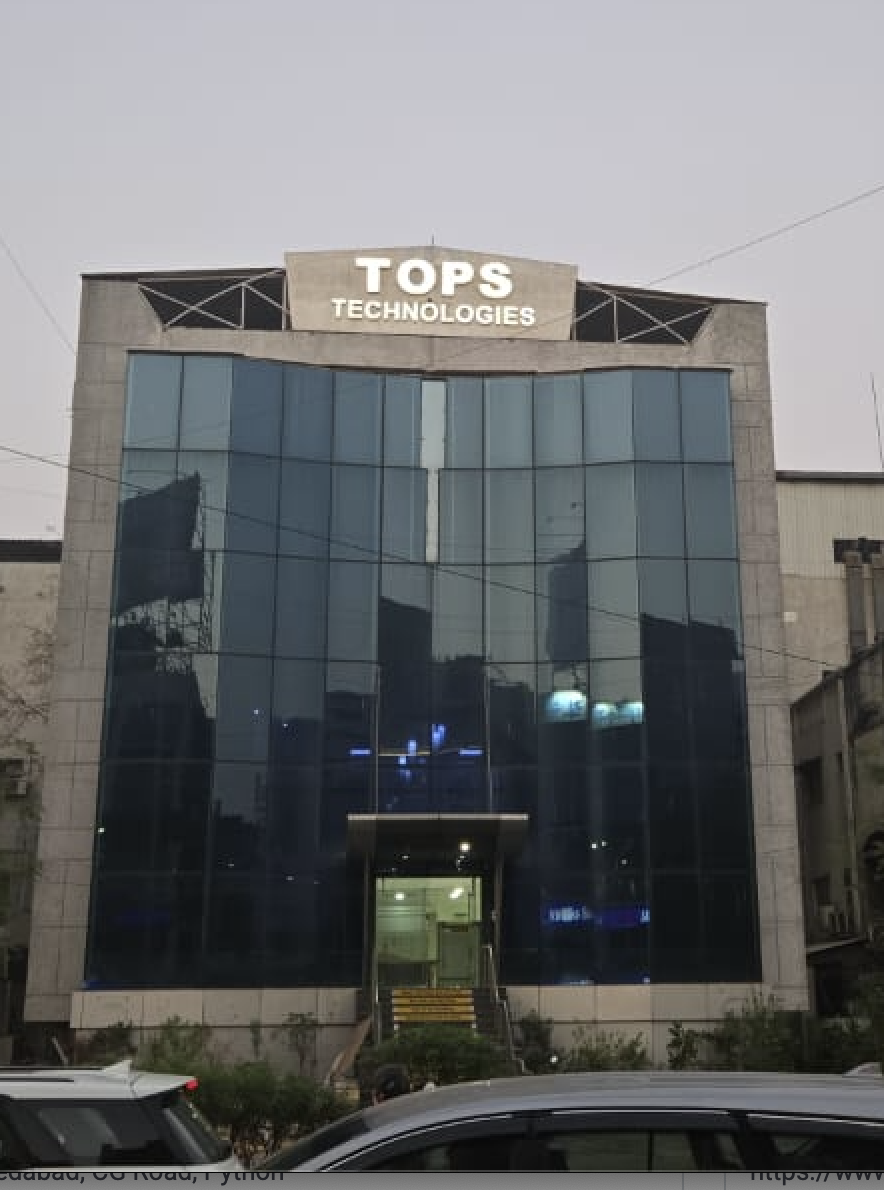Our Facts and Figures
Learn React Framework to become a highly sought-after web developer. At TOPS Technologies, our Best React Course provides hands-on training, Personalised attention, and job-oriented training that can help you enhance your programming skills and advance your career. Join now to become an expert in React Framework and achieve your career goals.
1 Lac+
Student Placed
3000+
Companies TieUp
19+
Offices in India
50+
Industry Courses
Get 100% Job Assistance by enrolling in Certified React Training Course
Key Highlights
Limited Students Batch
Personalised Attention
Highly Qualified Teachers
Flexible Batch Timings
Interactive Learning
Live Projects
Career Support
Job Oriented Training
ReactJS Course Highlights
What is React?
React is the most popular Javascript UI library backed by Facebook as well as a community of freelance developers. React is used to build user interfaces for single-page applications as well as mobile applications. The main concepts include lifecycle, Context, JSX Expression, and components. Popular applications like Yahoo! Mail, Dropbox, Instagram, WhatsApp, etc use React JS nowadays. With our Best React Course, you will be able to establish your career with an industry-recognized certification and also get placement assistance to help you land your dream job.
How Can Our Best React Course Help You?
Successful web developers are those who can build a dynamic front-end that’s fast, reliable, and scalable. With our ReactJS course, you will be introduced to the latest tools and technologies in ReactJS to help you develop robust web applications. Our learning module will help you grasp the fundamentals of ReactJs and gradually take you to the next level of advanced concepts with hands-on training and expert mentorship every step of the way.
A brief overview of what you will learn through our React JS Training:
- A strong foundation in ReactJS by learning about the various components, event handlers, props, JSX, and more through a series of hands-on training sessions.
- Grasp the fundamentals of working with ReactJS and various UI components.
- Learn all the concepts practically with Live projects and assignments.
- Dive deeper into ReactJS app deployment with personalized support from industry experts.
Why Choose React JS Tutorial from TOPS?
TOPS Technologies is the most trustable React Training Institute that focuses on ReactJS as well as React Native, which is used for creating the user interface in mobile applications. Ours React Full Course program concentrates on certifying candidates undergoing this training to build front-end applications.
Our ReactJS Course covers setting up the environment, component API, Forms and events, props overview and validation, Animation, and many such components to ensure hands-on practical exposure. We aim to provide you with a learning platform and enhance your knowledge about the best industry practices and become a proficient web developer.
Enroll in Our React JS Course Today to Kickstart Your Career!
40%
Average Salary Hike
4.5 Lacs
Highest Salary
3000+
Hiring Partners
Join Our Free Upcoming Webinar
Graphic Designing Career
11 Dec 2025, 04:00 PM
Trainer
Parth Patel
(Sr. Technical Trainer)
Learn Python in 60 Minutes
12 Dec 2025, 04:00 PM
Trainer
Sanket Chauhan
(Sr. Technical Trainer)
Motion Graphics and Animation in Design
14 Dec 2025, 11:00 AM
Trainer
Saurabh Verma
(Sr. Technical Trainer)
Career in Data Science
14 Dec 2025, 12:30 PM
Trainer
Dhrumil Joshi
(Sr. Technical Trainer)
How to Protect your Website from Hackers
14 Dec 2025, 02:00 PM
Trainer
Faruk Pathan
(Sr. Technical Trainer)
How to Create Dynamic Websites in Python with Django
14 Dec 2025, 04:00 PM
Trainer
Sanket Chauhan
(Sr. Technical Trainer)
Building a Full Stack Application from Scratch
13 Dec 2025, 10:30 AM
Trainer
Rahul Sanghavi CG
(Sr. Technical Trainer)
How to Get a Job with Internship
13 Dec 2025, 12:30 PM
Trainer
Jigar Thakkar
(Sr. Technical Trainer)
UI / UX Design - Role of UI / UX Design in Websites' Success
13 Dec 2025, 02:00 PM
Trainer
Gaurav singh tomar
(Sr. Technical Trainer)
Career in Cloud Computing
13 Dec 2025, 04:00 PM
Trainer
Faruk Pathan
(Sr. Technical Trainer)
ReactJS Course Curriculum
Download Curriculum- Course Overview
- Platforms, Frameworks & Tools
- Hybrid frameworks versus Native
- HTML5
- CSS3
- JS brush up
- ES6 Javascript Basics
- Tools Install
- React Native Hello World
- React Intro
- Getting started in React
- JSX
- Components
- Component Composition
- Props
- Prop Types
- Event Handlers
- State
- React Web App
- Creating the first App
- Understanding the App
- Styling the App
- Inspecting Debugging styles
- Built-in components
- Working with Images
- List Views
- Text Input
- Creating Views (Scenes)
- Storing data – Realm for React Native
- Integrating with Map APIs
- Creating native React components
- Routing
- Employee Directory App
- Integrating data using API
- API
- Wiring up Redux
- Asynchronous Network requests
- Dynamic properties
- Dynamic styles
- React Navigation Library
- Redux Basics
- Redux Principles
- Implementing Redux
- React-Redux
- Middleware
- Counter App Demo
Our TOPS Training Centers in India
Course Key Features
- Learn to Build Enterprise Level React Applications
- Master the Latest Ecosystem of React Developer
Skills Covered
- React
- Single Page Application
- Components
- JSX
- Events
- Iterations and Conditions
- Styling
- Dialog And Modals
- Fragments and Portals
- Class Based Components
- HTTP Module
- Custom Hook And Forms
- Redux
- Authentication
Job Roles
- Reactjs Developer
- Front End Developer
- UI Developer
Get Training Certificate by Government
Recognized NSDC/Skill India

- National Skill Development Corporation
- Supported by the vision of PM Shri Narendra Modi
- Certification by NSDC SkillIndia
- Valid for all Jobs and College Training
- International Recognition

FAQ
Functional components are simple JavaScript functions, while class components use ES6 classes and have access to lifecycle methods and state (before hooks).
Props (short for properties) are read-only inputs passed to components. They allow data flow from parent to child components.
State is a built-in object used to store data that changes over time. It determines how the component behaves and renders.
React JS is a powerful JavaScript library used for building dynamic and responsive user interfaces. At TOPS Technologies, you’ll learn React from industry experts through real-time projects, practical sessions, and hands-on training, making you job-ready in the competitive IT market.
React is a JavaScript library developed by Facebook for building user interfaces, especially single-page applications. It uses a component-based architecture and efficiently updates the user interface using a virtual DOM.
Key features include JSX syntax, component-based structure, virtual DOM, one-way data binding, reusable components, and support for hooks for functional programming.
JSX (JavaScript XML) is a syntax extension that allows writing HTML-like code in JavaScript. It makes the structure of UI components more readable and intuitive.
The virtual DOM is an in-memory representation of the real DOM. React compares the virtual DOM with a snapshot (diffing) and updates only the changed elements, improving performance.
The real DOM updates the entire tree, which is slow. The virtual DOM updates only the changed parts, making rendering more efficient and faster.
Components are reusable, independent pieces of UI that return JSX. There are two types: Functional Components and Class Components.
Interview Questions
React JS is an open-source JavaScript library developed by Facebook for building fast, interactive, and scalable user interfaces, primarily for single-page web applications. It focuses on creating reusable components that manage their own state, which makes it efficient to develop complex UIs. React handles view layers for both web and mobile apps and allows developers to create rich user interfaces with minimal code and high performance.
React JS offers several powerful features that simplify and enhance the development of modern applications:
- JSX (JavaScript XML): A syntactic extension that allows developers to write HTML-like code within JavaScript, improving code readability
- Virtual DOM: React maintains a virtual representation of the real DOM to optimize updates and rendering processes.
- Component-Based Architecture: Applications are divided into small, reusable, and independent pieces called components, making the code modular and maintainable.
- Unidirectional Data Flow: Data flows in one direction, from parent to child through props, ensuring predictable and easy-to-debug application behavior.
- Declarative UI: Developers describe what the UI should look like, and React handles the rendering and updates efficiently.
The Virtual DOM is a lightweight, in-memory representation of the actual Document Object Model (DOM). When a component’s state or props change, React updates the Virtual DOM first. It then compares this new version with the previous one using a process called “diffing.” After identifying the minimal number of changes needed, React updates only those parts of the real DOM. This selective update mechanism makes React highly performant and responsive.
JSX stands for JavaScript XML and is a syntax extension for JavaScript commonly used with React. It allows developers to write HTML-like code within JavaScript files, which makes it easier to visualize the UI structure. JSX is not understood by browsers directly; it is transpiled into standard JavaScript using tools like Babel. JSX improves development efficiency by combining markup and logic in a single component file.
A component in React is a fundamental building block used to create user interfaces. Components are JavaScript functions or classes that return React elements describing what should appear on the screen. There are two types of components:
- Functional Components: Simple JavaScript functions that return JSX.
- Class Components: ES6 classes that extend from React.Component and include lifecycle methods.
Components can manage their own state and can be reused across the application to ensure consistency and modular development.
- Functional Components are basic JavaScript functions that take props as input and return JSX. With the introduction of React Hooks, functional components can now manage state and side effects, making them just as powerful as class components.
- Class Components are based on ES6 classes and offer built-in lifecycle methods like componentDidMount, shouldComponentUpdate, etc., to manage component behavior.
- React now encourages the use of functional components due to their simplicity, improved performance, and cleaner syntax, especially when combined with hooks.
React Hooks are special functions introduced in React 16.8 that allow developers to use state and other React features in functional components. Before hooks, only class components could manage state or access lifecycle methods. With hooks, functional components became more powerful and concise. Commonly used hooks include:
- useState – for managing local state
- useEffect – for handling side effects
- useContext – for accessing global context
- useRef, useReducer, and others for advanced logic
Hooks simplify the code and encourage reusability and separation of concerns.
The useState hook is used in functional components to create and manage local state. It returns an array containing the current state value and a function to update it. This hook allows components to be interactive and dynamic. For example, clicking a button can change the state and re-render the UI with the new data. It enables functional components to store user input, toggle values, or track counters without needing a class.
The useEffect hook allows you to perform side effects in your React components, such as fetching data from APIs, updating the DOM, or setting up subscriptions. It runs after the component has rendered and can be controlled using a dependency array to decide when the effect should re-run. For example, passing an empty array runs the effect only once (like componentDidMount). useEffect helps manage lifecycle-related logic within functional components.
Props (short for properties) are inputs passed from a parent component to a child component. They are read-only and help make components reusable and dynamic. Props allow data to flow in one direction, ensuring a predictable UI. For example, a parent can send a name, color, or event handler to a child component through props. Inside the child, props are accessed to display content or trigger actions based on the parent’s data.
Latest Blogs
How to Make the Switch from Non-IT to IT?
Are you curious about the journey from non-IT to IT? Surprisingly, the door is wider open than you m...
View full BlogWhat Is React? – Unveiling the Secrets of Interac...
React is a popular option among developers because of its many benefits. The following are some stro...
View full BlogReactJS vs AngularJS: A Guide to JavaScript Framew...
Here we will talk about the two frameworks and one of the frequently neglected topics in such course...
View full Blog








